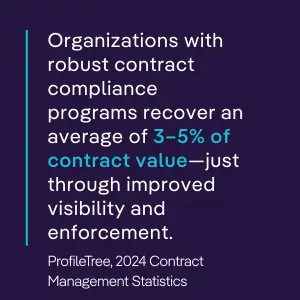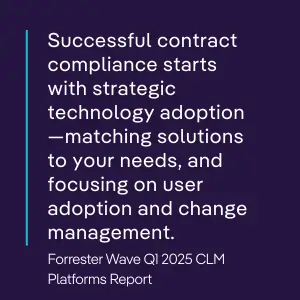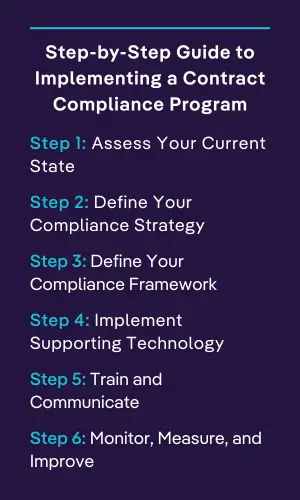Introduction
In today’s intricate business landscape, contracts govern nearly every significant business relationship and transaction. Yet many organizations fail to realize that signing a contract represents only the beginning of a value journey. Contract compliance—the systematic process of ensuring all parties fulfill contractual obligations—has emerged as a critical business function with direct impacts on financial performance, risk management, and operational excellence.
This comprehensive guide explores what contract compliance entails, its strategic importance, and how organizations can implement effective compliance practices. Whether managing complex supplier agreements, customer contracts, or regulatory requirements, mastering contract compliance principles can transform your contractual relationships from potential liabilities into valuable strategic assets.
What is Contract Compliance?
Contract compliance refers to the systematic monitoring and management of contractual obligations to ensure all parties meet their commitments as specified in the agreement. It encompasses both internal compliance (your organization meeting its obligations) and external compliance (ensuring other parties fulfill their responsibilities).
At its core, contract compliance involves tracking and enforcing contractual obligations throughout the agreement lifecycle; monitoring performance against specified metrics and standards; verifying pricing, discount structures, and billing accuracy; identifying and managing contractual risks proactively; and ensuring adherence to both contractual terms and applicable regulations.
Contract compliance isn’t a singular checkpoint but rather an ongoing discipline that spans the entire contract lifecycle from execution through renewal or termination.

Why Contract Compliance Matters: The Business Impact
The significance of contract compliance extends far beyond legal protection. Recent research shows that organizations lose approximately 9.2% of revenue annually due to poor contract management, with compliance issues representing a substantial portion of these losses. This statistic has remained consistent in World Commerce & Contracting’s 2024 effectiveness report, highlighting an ongoing challenge for businesses worldwide.
Furthermore, a 2024 study from ProfileTree’s contract management statistics analysis reveals that organizations with robust contract compliance programs recover an average of 3-5% of contract value through improved visibility and enforcement.
The Cost of Non-Compliance
Organizations with inadequate contract compliance mechanisms face numerous risks:
Financial Leakage: Unrealized discounts, pricing errors, missed volume incentives, and undetected billing discrepancies directly impact profitability.
Legal Vulnerability: Non-compliance can trigger breach of contract claims resulting in litigation, penalties, and damaged business relationships.
Operational Disruption: Service level agreement violations, missed deliveries, and quality issues can severely impact business continuity.
Reputational Damage: Repeated compliance failures erode trust and can permanently damage relationships with partners and customers.
Regulatory Penalties: In regulated industries, contract compliance failures can trigger significant fines and sanctions from oversight bodies.
Recent research published in Procurement Tactics’ 2025 Contract Management Statistics indicates that “between 55% and 70% of organizations lack efficient contract management systems,” leaving them particularly vulnerable to these risks.
The Four Pillars of Effective Contract Compliance
Implementing a robust contract compliance program requires a holistic approach built on four foundational elements:
1. People: Establishing Clear Accountability
Contract compliance begins with clear ownership and accountability. Organizations must define roles and responsibilities, clearly delineating who is responsible for monitoring different aspects of contract performance. Relevant personnel should receive training in contract review, obligation management, and compliance monitoring techniques. Cross-functional collaboration mechanisms are essential for legal, procurement, finance, and operations teams to work together effectively. Finally, securing executive support ensures leadership understands and champions the importance of contract compliance.
2. Process: Implementing Systematic Compliance Workflows
Effective contract compliance requires structured processes for obligation extraction and classification to systematically identify and categorize all contractual commitments. Organizations should establish consistent monitoring protocols for tracking performance and compliance, along with clear escalation pathways for addressing issues. Regular compliance reviews enable periodic assessments of contract performance, while continuous improvement mechanisms incorporate learnings into process refinements.
3. Technology: Leveraging Digital Tools
Modern contract compliance benefits significantly from purpose-built technology that establishes a centralized repository as a single source of truth for all contracts. These systems should include automated alerts for approaching deadlines and obligations, compliance dashboards that provide visual monitoring tools, and robust reporting capabilities to generate insights into compliance trends. Integration with ERP, procurement, and financial systems ensures contract data flows seamlessly across the organization.
The Forrester Wave Q2 2023 CLM report indicates that organizations implementing dedicated contract management technology achieve up to 55% faster contract cycles and reduce compliance-related costs by approximately 25%.
4. Governance: Establishing Oversight Mechanisms
Effective governance ensures compliance activities remain aligned with business objectives through documented compliance policies and standards that set clear expectations. Regular auditing validates adherence to these standards, while performance metrics track and report on key compliance indicators. Continuous training keeps teams updated on requirements and best practices, and a risk assessment framework helps prioritize compliance activities based on potential impact.

Contract Compliance Best Practices
1. Adopt a Risk-Based Approach
Not all contracts require the same level of compliance monitoring. Organizations should develop a contract risk assessment framework that categorizes agreements based on value, complexity, and strategic importance. This allows teams to allocate greater compliance resources to higher-risk agreements and tailor monitoring intensity to risk exposure, focusing limited resources where they’ll have the greatest impact.
2. Implement Proactive Compliance Monitoring
Proactive compliance monitoring helps organizations detect potential issues before they escalate and prevent revenue leakage through early identification. This approach helps maintain stronger relationships through proactive management and demonstrates commitment to compliance with regulators and partners, establishing your organization as a trusted business partner.
3. Measure and Report on Compliance Performance
Compliance metrics drive accountability by tracking obligation fulfillment rates and measuring the financial impact of compliance efforts. Regular monitoring of compliance-related costs and disputes, along with routine reporting on compliance status to key stakeholders, ensures visibility and ongoing improvement in compliance performance.

4. Leverage Technology Appropriately
The Forrester Wave Q1 2025 Contract Lifecycle Management Platforms report indicates that technology adoption should be strategic, matching capabilities to specific compliance needs and focusing on user adoption and change management. Organizations should integrate compliance tools with existing business systems and balance automation with human oversight to achieve optimal results.
The Future of Contract Compliance: Emerging Trends
Artificial Intelligence and Machine Learning
AI and ML are transforming contract compliance through automated obligation identification and extraction, predictive analytics to forecast compliance issues, natural language processing for contract analysis, and intelligent compliance monitoring and alerting.
Blockchain and Smart Contracts
Distributed ledger technology offers promising applications for compliance through self-executing contract terms that automate verification and enforcement. These technologies create immutable audit trails of contractual activities, enable transparent performance tracking across parties, and facilitate automated verification of compliance conditions, reducing the need for manual oversight.
Integrated Compliance Ecosystems
The future of contract compliance involves connected systems that provide end-to-end visibility across contract portfolios and real-time compliance dashboards for executives. Cross-contract analytics will help identify broader trends, while supplier network integration enables seamless monitoring across the value chain, creating a comprehensive compliance ecosystem.
Implementing a Contract Compliance Program: A Step-by-Step Guide

Step 1: Assess Your Current State
Before implementing new compliance measures, evaluate your existing contract management processes and identify compliance gaps and recurring issues. Review historical compliance incidents and benchmark your current practices against industry standards to establish a clear baseline for improvement.
Step 2: Define Your Compliance Strategy
Build a compliance approach aligned with business objectives by establishing clear compliance goals and defining the scope of your program. Determine the necessary resource requirements and secure executive sponsorship to ensure the program has the support needed for successful implementation.
Step 3: Develop Your Compliance Framework
Create the structure for your program by documenting compliance policies and procedures and defining roles and responsibilities across the organization. Establish governance structures and develop compliance metrics and reporting mechanisms that will provide ongoing visibility into program performance.
Step 4: Implement Supporting Technology
Select and deploy appropriate technology solutions that meet your specific compliance needs. Choose contract management software with robust compliance capabilities and configure obligation tracking and alerting functions. Implement reporting and analytics tools and integrate with existing business systems to create a cohesive technology ecosystem.
Deloitte’s 2023 third-party risk management survey found that over 51% of organizations have become more focused on integrating business strategy and risk management into their contract management approach, indicating a growing awareness of the strategic importance of contract compliance.
Step 5: Train and Communicate
Ensure all stakeholders understand their compliance responsibilities through role-specific training programs and clear compliance guidelines. Establish communication channels for compliance questions and promote the value of compliance across the organization to build a strong compliance culture.
Step 6: Monitor, Measure, and Improve
Continuously enhance your compliance program by conducting regular compliance audits and tracking and analyzing compliance metrics. Identify improvement opportunities based on performance data and adjust processes based on outcomes to drive ongoing enhancement of your compliance capabilities.
How ContractPodAi Can Transform Your Contract Compliance
ContractPodAi’s comprehensive contract lifecycle management platform empowers organizations to streamline compliance processes through AI-powered obligation management that automatically extracts, tracks, and manages contractual obligations with intelligent alerting. Our centralized contract repository stores all contracts in a secure, searchable database with advanced filtering capabilities, while automated compliance workflows configure custom processes to ensure compliance activities happen on schedule.
Real-time compliance dashboards provide immediate visibility into compliance status across your contract portfolio, and our risk management tools help identify and mitigate compliance risks before they impact your business. Integration capabilities connect contract data with your broader business ecosystem, creating a seamless compliance environment.

Conclusion
Contract compliance is no longer a back-office legal function—it’s a strategic business imperative with direct impacts on financial performance, risk management, and operational excellence. By implementing robust compliance processes supported by appropriate technology, organizations can transform contract compliance from a risk management activity into a source of competitive advantage.
Whether your goal is to prevent revenue leakage, strengthen supplier relationships, or better manage contractual risk, investing in contract compliance capabilities delivers measurable business value. The combination of well-defined processes, engaged stakeholders, and purpose-built technology creates a foundation for compliance excellence that supports broader business objectives.
Discover how ContractPodAi can transform your approach to contract compliance. Schedule a personalized demo today to see our contract compliance tools in action and learn how leading organizations are leveraging our platform to drive business value through improved compliance.








